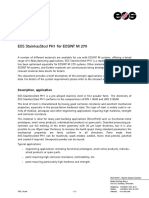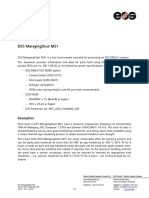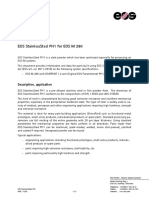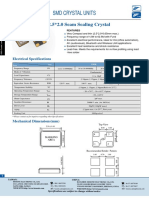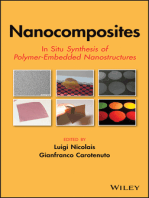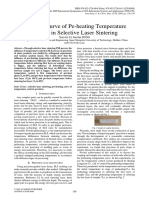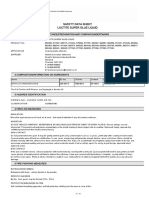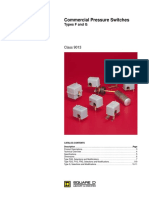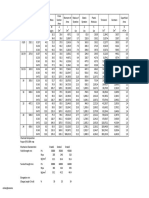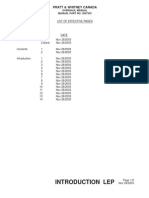Material Data Sheet: Eos Maragingsteel Ms1
Material Data Sheet: Eos Maragingsteel Ms1
Uploaded by
qualityfreekCopyright:
Available Formats
Material Data Sheet: Eos Maragingsteel Ms1
Material Data Sheet: Eos Maragingsteel Ms1
Uploaded by
qualityfreekOriginal Title
Copyright
Available Formats
Share this document
Did you find this document useful?
Is this content inappropriate?
Copyright:
Available Formats
Material Data Sheet: Eos Maragingsteel Ms1
Material Data Sheet: Eos Maragingsteel Ms1
Uploaded by
qualityfreekCopyright:
Available Formats
Material data sheet
EOS MaragingSteel MS1
EOS MaragingSteel MS1 is a steel powder which has been optimized especially for processing
on EOSINT M systems.
This document provides information and data for parts built using EOS MaragingSteel MS1
powder (EOS art.-no. 9011-0016) on the following system specifications:
- EOSINT M 270 Installation Mode Standard
with PSW 3.3 or 3.4 and default job MS1_020_default.job or MS1_040_default.job
- EOSINT M 270 Dual Mode
with PSW 3.5 and EOS Original Parameter Set MS1_Surface 1.0 or MS1_Performance 2.0
- EOSINT M 280
with PSW 3.5 and EOS Original Parameter Set MS1_Performance 1.0 or MS1_Speed 1.0
Description
Parts built in EOS MaragingSteel MS1 have a chemical composition corresponding to US classi-
fication 18% Ni Maraging 300, European 1.2709 and German X3NiCoMoTi 18-9-5. This kind of
steel is characterized by having very good mechanical properties, and being easily heat-
treatable using a simple thermal age-hardening process to obtain excellent hardness and
strength.
Parts built from EOS MaragingSteel MS1 are easily machinable after the building process and
can be easily post-hardened to more then 50 HRC by age-hardening at 490 °C (914 °F) for 6
hours. In both as-built and age-hardened states the parts can be machined, spark-eroded,
welded, micro shot-peened, polished and coated if required. Due to the layerwise building
method, the parts have a certain anisotropy, which can be reduced or removed by appropriate
heat treatment - see Technical Data for examples.
EOS GmbH - Electro Optical Systems
Robert-Stirling-Ring 1
D-82152 Krailling / München
Telephone: +49 (0)89 / 893 36-0
EOS MaragingSteel MS1 Telefax: +49 (0)89 / 893 36-285
TMS, WEIL / 10.2011 1/6 Internet: www.eos.info
Material data sheet
Technical data
General process data
Typical achievable part accuracy [1]
- small parts (< 80 x 80 mm) approx. 20 µm
approx. 0.8 x 10-³ inch
- large parts approx. 50 µm
approx. 0.002 inch
Age hardening shrinkage [2] approx. 0.08 %
Min. wall thickness [3] approx. 0.3 - 0.4 mm
approx. 0.012 - 0.016 inch
Surface roughness (approx.) [4]
- as manufactured
MS1 Surface (20 µm) Ra 4 µm; Rz 20 µm
Ra 0.16 x 10-³ inch,
Rz 0.78 x 10-³ inch
MS1 Performance (40 µm) Ra 5 µm; Rz 28 µm
Ra 0.19 x 10-³ inch,
Rz 1.10 x 10-³ inch
MS1 Speed (50 µm) Ra 9 µm; Rz 50 µm
Ra 0.47 x 10-³ inch,
Rz 2.36 x 10-³ inch
- after shot-peening Ra 4 - 6.5 µm; Rz 20 - 50 µm
Ra 0.16 – 0.26 x 10-³ inch
Rz 0.78 – 1.97 x 10-³ inch
- after polishing Rz up to < 0.5 µm
Rz up to < 0.02 x 10-³ inch
(can be very finely polished)
EOS GmbH - Electro Optical Systems
EOS MaragingSteel MS1 Robert-Stirling-Ring 1
TMS, WEIL / 10.2011 2/6 D-82152 Krailling / München
Material data sheet
Volume rate [5]
- Parameter set MS1_Surface 1.0 / default job 1.6 mm³/s (5.8 cm³/h)
MS1_020_default.job (20 µm layer thickness) 0.35 in³/h
- Parameter set MS1_Performance 2.0 / default job 3 mm³/s (10.8 cm³/h)
MS1_040_default.job (40 µm layer thickness) 0.66 in³/h
- Parameter set MS1_Performance 1.0 / for M 280 / 400 W 4.2 mm³/s (15.1 cm³/h)
(40 µm layer thickness) 0.92 in³/h
- Parameter set MS1_Speed 1.0 / for M 280 / 400 W 5.5 mm³/s (19.8 cm³/h)
(50 µm layer thickness) 1.21 in³/h
[1] Based on users' experience of dimensional accuracy for typical geometries, as built. Part accuracy is subject to
appropriate data preparation and post-processing, in accordance with EOS training.
[2] Ageing temperature 490 °C (914 °F), 6 hours, air cooling
[3] Mechanical stability is dependent on geometry (wall height etc.) and application
[4] Due to the layerwise building, the surface structure depends strongly on the orientation of the surface, for
example sloping and curved surfaces exhibit a stair-step effect. The values also depend on the measurement
method used. The values quoted here given an indication of what can be expected for horizontal (up-facing)
or vertical surfaces.
[5] Volume rate is a measure of build speed during laser exposure of hatched areas. The total build speed depends
on the average volume rate, the recoating time (related to the number of layers) and other geometry- and
machine setting-related factors.
EOS GmbH - Electro Optical Systems
EOS MaragingSteel MS1 Robert-Stirling-Ring 1
TMS, WEIL / 10.2011 3/6 D-82152 Krailling / München
Material data sheet
Physical and chemical properties of parts
Material composition Fe (balance)
Ni (17 - 19 wt-%)
Co (8.5 - 9.5 wt-%)
Mo (4.5 - 5.2 wt-%)
Ti (0.6 - 0.8 wt-%)
Al (0.05 - 0.15 wt-%)
Cr, Cu (each 0.5 wt-%)
C ( 0.03 wt-%)
Mn, Si (each 0.1 wt-%)
P, S (each 0.01 wt-%)
Relative density approx. 100 %
Density 8.0 - 8.1 g/cm³
0.289 - 0.293 lb/in³
EOS GmbH - Electro Optical Systems
EOS MaragingSteel MS1 Robert-Stirling-Ring 1
TMS, WEIL / 10.2011 4/6 D-82152 Krailling / München
Material data sheet
Mechanical properties of parts at 20 °C ( 68°F )
As built After age hardening [2]
Tensile strength [6] min. 1930 MPa
min. 280 ksi
- in horizontal direction (XY) typ. 1100 ± 100 MPa
typ. 160 ± 15 ksi typ. 2050 ± 100 MPa
- in vertical direction (Z) typ. 1100 ± 100 MPa typ. 297 ± 15 ksi
typ. 160 ± 15 ksi
Yield strength (Rp 0.2 %) [6] min. 1862 MPa
min. 270 ksi
- in horizontal direction (XY) typ. 1050 ± 100 MPa
typ. 152 ± 15 ksi typ. 1990 ± 100 MPa
- in vertical direction (Z) typ. 1000 ± 100 MPa typ. 289 ± 15 ksi
typ. 145 ± 15 ksi
Elongation at break [6] min. 2 %
- in horizontal direction (XY) typ. (10 ± 4 ) %
typ. (4 ± 2) %
- in vertical direction (Z) typ. (10 ± 4 ) %
Modulus of elasticity [6]
- in horizontal direction (XY) typ. 160 ± 25 GPa
typ. 23 ± 4 Msi typ. 180 ± 20 GPa
- in vertical direction (Z) typ. 150 ± 20 GPa typ. 26 ± 3 Msi
typ. 22 ± 3 Msi
Hardness [7] typ. 33 - 37 HRC typ. 50 - 56 HRC
Ductility (Notched Charpy impact test) typ. 45 ± 10 J typ. 11 ± 4 J
[6] Tensile testing according to ISO 6892-1:2009 (B) Annex D, proportional test pieces, diameter of the neck area
5mm (0.2 inch), original gauge length 25mm (1 inch).
[7] Rockwell C (HRC) hardness measurement according to EN ISO 6508-1 on polished surface. Note that measu-
red hardness can vary significantly depending on how the specimen has been prepared.
EOS GmbH - Electro Optical Systems
EOS MaragingSteel MS1 Robert-Stirling-Ring 1
TMS, WEIL / 10.2011 5/6 D-82152 Krailling / München
Material data sheet
Thermal properties of parts
As built After age hardening [2]
Thermal conductivity typ. 15 ± 0.8 W/m°C typ. 20 ± 1 W/m°C
typ. 104 ± 6 Btu in/(h ft² °F) typ. 139 ± 7 Btu in/(h ft² °F)
Specific heat capacity typ. 450 ± 20 J/kg°C typ. 450 ± 20 J/kg°C
typ. 0.108 ± 0.005 Btu/(lb °F) typ. 0.108 ± 0.005 Btu/(lb °F)
Maximum operating temperature approx. 400 °C
approx. 750 °F
Abbreviations
typ. typical
min. minimum
approx. approximately
wt weight
Notes
The data are valid for the combinations of powder material, machine and parameter sets referred to on page 1,
when used in accordance with the relevant Operating Instructions (including Installation Requirements and
Maintenance) and Parameter Sheet. Part properties are measured using defined test procedures. Further details of
the test procedures used by EOS are available on request. Unless otherwise specified, the data refer to the default
job MS1_040_default.job or the equivalent parameter set MS1_Performance 2.0. The corresponding data for the
default job MS1_020_default.job or the equivalent parameter set MS1_Surface 1.0 are approximately the same
except where otherwise specified.
The data correspond to our knowledge and experience at the time of publication. They do not on their own provide
a sufficient basis for designing parts. Neither do they provide any agreement or guarantee about the specific prop-
erties of a part or the suitability of a part for a specific application. The producer or the purchaser of a part is
responsible for checking the properties and the suitability of a part for a particular application. This also applies re-
garding any rights of protection as well as laws and regulations. The data are subject to change without notice as
part of EOS' continuous development and improvement processes.
EOS, EOSINT and DMLS are registered trademarks of EOS GmbH.
2011 EOS GmbH – Electro Optical Systems. All rights reserved.
EOS GmbH - Electro Optical Systems
EOS MaragingSteel MS1 Robert-Stirling-Ring 1
TMS, WEIL / 10.2011 6/6 D-82152 Krailling / München
You might also like
- ZF Repair Manual PDFDocument96 pagesZF Repair Manual PDFDr Mesin100% (13)
- Laser Cutting ParametersDocument55 pagesLaser Cutting ParametersQasim Ali100% (3)
- Raycus CW Fiber Laser 500-20000W Cutting ParametersDocument58 pagesRaycus CW Fiber Laser 500-20000W Cutting ParametersAsdf100% (2)
- Breather Valve CalcDocument12 pagesBreather Valve Calczamijaka100% (1)
- Manual Sewergems Sewercad UnicampDocument300 pagesManual Sewergems Sewercad Unicampvetho100% (5)
- Documents - Tips - Final Draft Thermo000 PDFDocument222 pagesDocuments - Tips - Final Draft Thermo000 PDFYoshua Martel Candava77% (13)
- Material Data Sheet: Eos Maragingsteel Ms1Document5 pagesMaterial Data Sheet: Eos Maragingsteel Ms1cute7707No ratings yet
- Material Data Sheet: DescriptionDocument7 pagesMaterial Data Sheet: DescriptionCharles SedilloNo ratings yet
- Material Data Sheet: Eos Stainlesssteel Gp1 For Eosint M 270Document5 pagesMaterial Data Sheet: Eos Stainlesssteel Gp1 For Eosint M 270Charles SedilloNo ratings yet
- Material Data Sheet: Description, ApplicationDocument5 pagesMaterial Data Sheet: Description, ApplicationCharles SedilloNo ratings yet
- Material Data Sheet: Eos Stainlesssteel Ph1 For Eosint M 270Document5 pagesMaterial Data Sheet: Eos Stainlesssteel Ph1 For Eosint M 270Charles SedilloNo ratings yet
- CoCr MP1 M270 Material Data SheetDocument6 pagesCoCr MP1 M270 Material Data Sheetgpiprototype.comNo ratings yet
- NiAll-IN625-M270 Material Data Sheet 10-11 en PDFDocument5 pagesNiAll-IN625-M270 Material Data Sheet 10-11 en PDFqualityfreekNo ratings yet
- Eos Stainless Steel 316 LDocument5 pagesEos Stainless Steel 316 LsameeraNo ratings yet
- Aluminum AlSi10Mg PDFDocument5 pagesAluminum AlSi10Mg PDFlucaNo ratings yet
- Material Data Sheet: Eos Maragingsteel Ms1Document5 pagesMaterial Data Sheet: Eos Maragingsteel Ms1Raj RajeshNo ratings yet
- NiAll-HX-M290-400W Material Data Sheet 10-15 enDocument5 pagesNiAll-HX-M290-400W Material Data Sheet 10-15 enAmit PowarNo ratings yet
- Ti64 PDFDocument5 pagesTi64 PDFqualityfreekNo ratings yet
- DM20 M270 Material Data SheetDocument4 pagesDM20 M270 Material Data Sheetgpiprototype.comNo ratings yet
- Eos Ti64 9011-0014 9011-0039 m290 Mds 06-22 enDocument10 pagesEos Ti64 9011-0014 9011-0039 m290 Mds 06-22 ennicoleta.popa2093No ratings yet
- Material Data Sheet - Flexline: Eos Stainlesssteel CXDocument4 pagesMaterial Data Sheet - Flexline: Eos Stainlesssteel CXRaj RajeshNo ratings yet
- Aluminium Data SheetDocument6 pagesAluminium Data SheetAta AtasoyNo ratings yet
- Material Data Sheet: DescriptionDocument6 pagesMaterial Data Sheet: DescriptionRaj RajeshNo ratings yet
- Material Data Sheet - Flexline: DescriptionDocument4 pagesMaterial Data Sheet - Flexline: DescriptionRaj RajeshNo ratings yet
- Metal InformationDocument1 pageMetal Informationvaishakh nairNo ratings yet
- EOS Material-Datasheet Stainless-Steel-PH1 M290 en PDFDocument5 pagesEOS Material-Datasheet Stainless-Steel-PH1 M290 en PDFMiguel A. ChávezNo ratings yet
- Material Data Sheet - Flexline: DescriptionDocument4 pagesMaterial Data Sheet - Flexline: DescriptionRaj RajeshNo ratings yet
- RF Sheet Resistance Rev 7Document38 pagesRF Sheet Resistance Rev 7nirav.kateshiyaNo ratings yet
- Dolinsek 2004Document7 pagesDolinsek 2004GauravNo ratings yet
- EOS Ti64 9011-0039 M400-MDS FlexLine 02-17 en PDFDocument4 pagesEOS Ti64 9011-0039 M400-MDS FlexLine 02-17 en PDFRaj RajeshNo ratings yet
- Material Data Sheet - Flexline: DescriptionDocument4 pagesMaterial Data Sheet - Flexline: DescriptionRaj RajeshNo ratings yet
- Datasheet Ring Cores (Toroides de Ferrite)Document21 pagesDatasheet Ring Cores (Toroides de Ferrite)Martín Mura0% (1)
- EOS Titanium TiCP Grade 2 - M290 - Material - Data - Sheet - 05-16 - FlexLine - en PDFDocument4 pagesEOS Titanium TiCP Grade 2 - M290 - Material - Data - Sheet - 05-16 - FlexLine - en PDFrajatNo ratings yet
- Data Sheet of Cobalt ChromiumDocument6 pagesData Sheet of Cobalt ChromiumDeva RajNo ratings yet
- 10 - Chapter 5Document16 pages10 - Chapter 5Abhijeet GangulyNo ratings yet
- ANG SPLOSNI KATALOG 2020 TerazzoDocument8 pagesANG SPLOSNI KATALOG 2020 TerazzoczorlubasNo ratings yet
- SUPRA50®: Chemical Composition (Weight %)Document3 pagesSUPRA50®: Chemical Composition (Weight %)malaya tripathyNo ratings yet
- TimingDevice XRCGB For ConsumerDocument2 pagesTimingDevice XRCGB For Consumerandreastudent803No ratings yet
- z3T - Maraging Steel 1-2709 (EOS MS1)Document1 pagez3T - Maraging Steel 1-2709 (EOS MS1)martinm3tNo ratings yet
- Ring Cores General Information: Ferrite Ring Metal Poles UDocument21 pagesRing Cores General Information: Ferrite Ring Metal Poles UMuhammad ImranNo ratings yet
- SS GP1 M270 - 04 09 - enDocument5 pagesSS GP1 M270 - 04 09 - enPiotr PawłowskiNo ratings yet
- Aço 1.4301 - INOX 304Document3 pagesAço 1.4301 - INOX 304Rhani NogueiraNo ratings yet
- OPGW-24B1.3-105 (58 100.0) ITU-TG.652.D Fibers: Characteristics of Cable Cable Construction and ParameterDocument5 pagesOPGW-24B1.3-105 (58 100.0) ITU-TG.652.D Fibers: Characteristics of Cable Cable Construction and ParameterAdanNo ratings yet
- PCB Capability ManualDocument7 pagesPCB Capability Manualspcb100% (3)
- EE407 Lec 27 28 1 PDFDocument14 pagesEE407 Lec 27 28 1 PDFBohraNo ratings yet
- GYTS-Cable Specifications G655DDocument7 pagesGYTS-Cable Specifications G655DcxhernanNo ratings yet
- NIC Components Current Sensing Resistor GuideDocument1 pageNIC Components Current Sensing Resistor GuideNICCompNo ratings yet
- Plastic OpticsDocument35 pagesPlastic Opticskerbla100% (2)
- E2SB Series 2.5 2.0 Seam Sealing CrystalDocument1 pageE2SB Series 2.5 2.0 Seam Sealing CrystalMaksimUSNo ratings yet
- 3 - Photoresist TechnologyDocument87 pages3 - Photoresist TechnologyLoiLeVanNo ratings yet
- DB26640448ENDocument3 pagesDB26640448ENaniba hamzaNo ratings yet
- Form Talysurf Intra Handbook 1 5Document190 pagesForm Talysurf Intra Handbook 1 5gautam.a2k15No ratings yet
- 1 s2.0 S221201731630041X MainDocument7 pages1 s2.0 S221201731630041X MainTrupti bagalNo ratings yet
- z3T - Dental Cobalt Chrome Alloy (EOS CC SP2)Document1 pagez3T - Dental Cobalt Chrome Alloy (EOS CC SP2)martinm3tNo ratings yet
- Family - Fiber Optic Patch Cords: MT Mpo/Mtp/MtDocument2 pagesFamily - Fiber Optic Patch Cords: MT Mpo/Mtp/MtMohan KNo ratings yet
- Alambron CHQDocument4 pagesAlambron CHQJavier GranadosNo ratings yet
- Data Sheet Raex 450Document3 pagesData Sheet Raex 450Amit GauravNo ratings yet
- FOC - CAT 1 CableDocument2 pagesFOC - CAT 1 CablesuchpewNo ratings yet
- Optimization of Machining Parameters in Wire Cut Electric Discharge Machining of Inconel 600Document24 pagesOptimization of Machining Parameters in Wire Cut Electric Discharge Machining of Inconel 600noble aNo ratings yet
- Gjyxch 8 Core FTTH Drop Cable: PecificationDocument2 pagesGjyxch 8 Core FTTH Drop Cable: PecificationluiggiNo ratings yet
- Application: Sheath Marking: Printed in White Ink, at Each Meter IntervalDocument2 pagesApplication: Sheath Marking: Printed in White Ink, at Each Meter IntervalJason SecretNo ratings yet
- Optical Engineering of DiamondFrom EverandOptical Engineering of DiamondRich MildrenRating: 4 out of 5 stars4/5 (11)
- Nanocomposites: In Situ Synthesis of Polymer-Embedded NanostructuresFrom EverandNanocomposites: In Situ Synthesis of Polymer-Embedded NanostructuresLuigi NicolaisNo ratings yet
- Material Data Sheet: ApplicationDocument2 pagesMaterial Data Sheet: ApplicationqualityfreekNo ratings yet
- Hitepaper: Tooling Applications With Eosint MDocument9 pagesHitepaper: Tooling Applications With Eosint MqualityfreekNo ratings yet
- Ti64 PDFDocument5 pagesTi64 PDFqualityfreekNo ratings yet
- Guidelines-3D DesignDocument3 pagesGuidelines-3D DesignqualityfreekNo ratings yet
- Eosint Technology For Direct Metal Laser-Sintering (DMLS)Document53 pagesEosint Technology For Direct Metal Laser-Sintering (DMLS)qualityfreekNo ratings yet
- Material Data Sheet: ApplicationDocument2 pagesMaterial Data Sheet: ApplicationqualityfreekNo ratings yet
- Ceramics PDFDocument5 pagesCeramics PDFqualityfreekNo ratings yet
- Accura 60 - WatershedDocument2 pagesAccura 60 - WatershedqualityfreekNo ratings yet
- DS Accura 25 USDocument2 pagesDS Accura 25 USqualityfreekNo ratings yet
- NiAll-IN625-M270 Material Data Sheet 10-11 en PDFDocument5 pagesNiAll-IN625-M270 Material Data Sheet 10-11 en PDFqualityfreekNo ratings yet
- Accura Clearvue US PDFDocument2 pagesAccura Clearvue US PDFqualityfreekNo ratings yet
- Study On Curve of Pe-Heating Temperature Control in Selective Laser SinteringDocument3 pagesStudy On Curve of Pe-Heating Temperature Control in Selective Laser SinteringqualityfreekNo ratings yet
- Safety Data Sheet Loctite Super Glue Liquid: 1 Identification of The Substance/Preparation and Company/UndertakingDocument4 pagesSafety Data Sheet Loctite Super Glue Liquid: 1 Identification of The Substance/Preparation and Company/UndertakingqualityfreekNo ratings yet
- Validation Theory and Application: Presented By: Mrs. Remedios A. RiveraDocument227 pagesValidation Theory and Application: Presented By: Mrs. Remedios A. RiveraqualityfreekNo ratings yet
- A Designer'S Guide For Dimensioning and Tolerancing Sls PartsDocument11 pagesA Designer'S Guide For Dimensioning and Tolerancing Sls PartsqualityfreekNo ratings yet
- Lattice Structure and Investment CastingDocument15 pagesLattice Structure and Investment CastingqualityfreekNo ratings yet
- ABS-M30: Real Production-Grade ThermoplasticDocument2 pagesABS-M30: Real Production-Grade ThermoplasticqualityfreekNo ratings yet
- Improvement of SLS Part AccuracyDocument11 pagesImprovement of SLS Part AccuracyqualityfreekNo ratings yet
- Ssurface Finish of SLS Using A RobotDocument10 pagesSsurface Finish of SLS Using A RobotqualityfreekNo ratings yet
- Surface RoughnessDocument14 pagesSurface RoughnessqualityfreekNo ratings yet
- Heat Balance SupportDocument9 pagesHeat Balance SupportqualityfreekNo ratings yet
- KEENSERT Installation Guide PDFDocument2 pagesKEENSERT Installation Guide PDFqualityfreekNo ratings yet
- Sample Project Flow ChartDocument4 pagesSample Project Flow Chartiswkim100% (7)
- 16 02 Zse Ise40Document10 pages16 02 Zse Ise40Popescu StefanNo ratings yet
- Conversion of Pressure and Power UnitsDocument17 pagesConversion of Pressure and Power Unitsber tingNo ratings yet
- Atmospheric PressureDocument1 pageAtmospheric Pressurerampw14581No ratings yet
- RTP 2500 FR ADocument2 pagesRTP 2500 FR ASoopNo ratings yet
- Bugtai Plt5 ShaftsDocument6 pagesBugtai Plt5 ShaftsChristille BugtaiNo ratings yet
- Enable™ 3505MC: Performance PolymerDocument2 pagesEnable™ 3505MC: Performance PolymerSiti Susi SulastriNo ratings yet
- Instrumentation and ControlDocument121 pagesInstrumentation and ControlabbutalibbNo ratings yet
- Wheatland Tube Company: Wheatland ASTM A 53 Schedule 80 PipeDocument2 pagesWheatland Tube Company: Wheatland ASTM A 53 Schedule 80 PipeAnder Lasa GNo ratings yet
- Roark's Formula 0 14Document1 pageRoark's Formula 0 14Jay CeeNo ratings yet
- Minimess CouplingDocument39 pagesMinimess Couplingani_datNo ratings yet
- Conversion Factors For U.S./British and Metric UnitsDocument4 pagesConversion Factors For U.S./British and Metric UnitsAnonymous mq0U43UsPNo ratings yet
- Refrigeration: TopicsDocument95 pagesRefrigeration: TopicsjroselNo ratings yet
- Control Valve Questions PDFDocument106 pagesControl Valve Questions PDFRajesh Krishnamoorthy80% (5)
- Ficha TecnicaDocument12 pagesFicha TecnicaLuciano Perez PerezNo ratings yet
- 7MF0300 Highlighted PDFDocument81 pages7MF0300 Highlighted PDFmajmor-1No ratings yet
- Api 682 Mechanical Seal Data Sheet For Centrifugal and Rotary PumpsDocument2 pagesApi 682 Mechanical Seal Data Sheet For Centrifugal and Rotary PumpsSakthikumar Chandrasekaran100% (3)
- 2660/2680 SERIES: ModelsDocument4 pages2660/2680 SERIES: Modelssandra montesNo ratings yet
- NRC Generic Fundamentals Examination Question Bank - BWR August 2015Document14 pagesNRC Generic Fundamentals Examination Question Bank - BWR August 2015elsayedNo ratings yet
- Astm A252Document1 pageAstm A252Mohammad Faqih MaulanaNo ratings yet
- Acronyms PDFDocument8 pagesAcronyms PDFOscar PalaciosNo ratings yet
- The Enthalpy - Entropy Diagram For Steam (MOLLIER CHART) : Problems On Processes of VaporsDocument5 pagesThe Enthalpy - Entropy Diagram For Steam (MOLLIER CHART) : Problems On Processes of VaporsEnriv Yasilad50% (4)
- TPO Versico Over LWICDocument23 pagesTPO Versico Over LWICRafael Ramirez CasateNo ratings yet
- Quadri GageDocument2 pagesQuadri GageKeron TrotzNo ratings yet
- Thermodynamics Chapter 3 Solution Sta MariaDocument7 pagesThermodynamics Chapter 3 Solution Sta MariaJean PD81% (21)
- Appendix G - Nonmandatory Examples Illustrating The Application of Code Formulas and RulesDocument20 pagesAppendix G - Nonmandatory Examples Illustrating The Application of Code Formulas and Rulesel_koptan00857693No ratings yet
- Front IntrDocument18 pagesFront Intrhasanjj100No ratings yet










